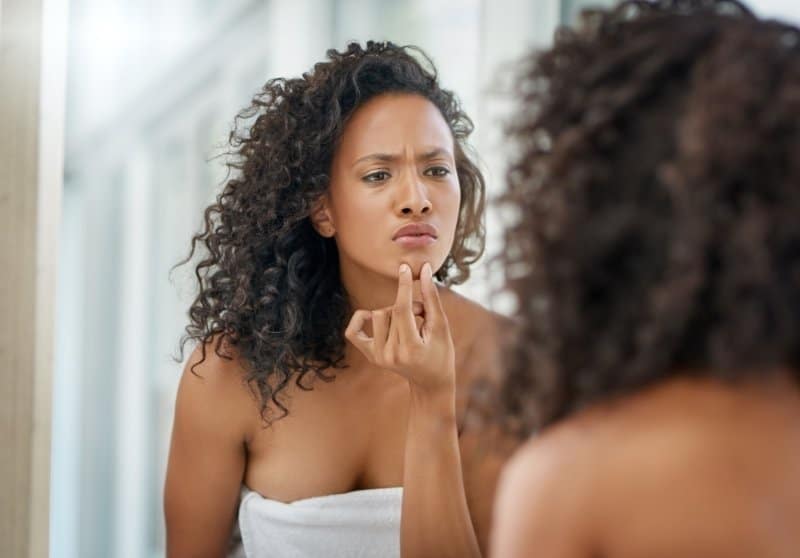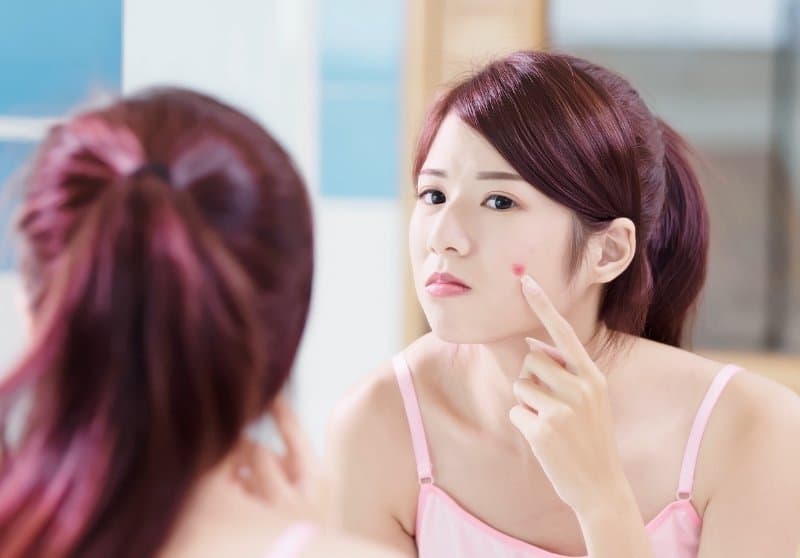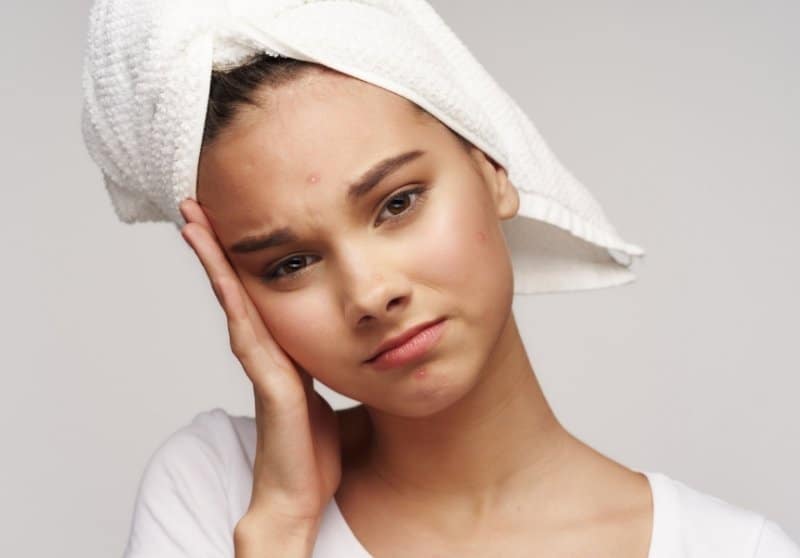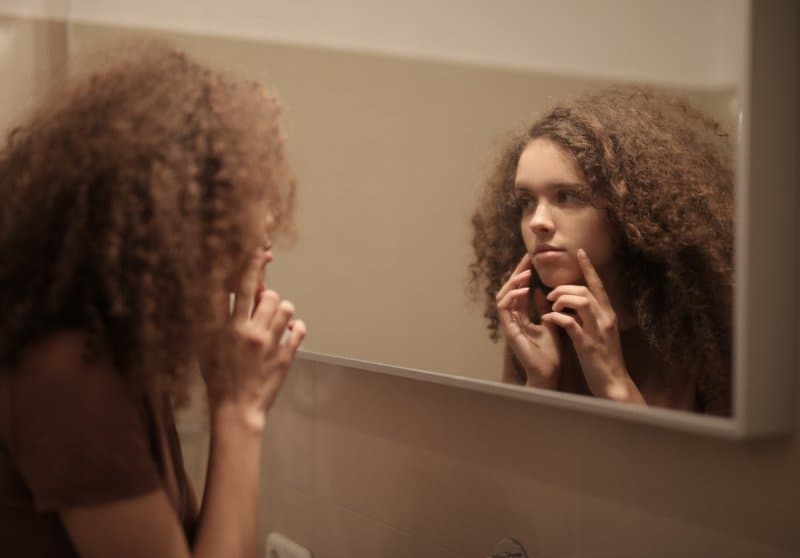Skin breakouts can be hard to control, but sometimes the underlying issue could be as simple as the hair products you’re using. Read on to find the causes of skin breakouts and how different hair products factor into the problem.

Hair products like hair dye, shampoo, conditioner, gel, or mousse can cause breakouts if they contain comedogenic or pore-clogging ingredients.
This phenomenon is called acne cosmetica, a mild form of acne caused by the application of cosmetics and which looks like small bumps on the skin or scalp.
What Usually Causes Breakouts?

Breakouts or pimples are caused by various factors, including environmental pollution, diet, hormonal imbalances, ingrown hair, dead skin cells, and excess oils.
They usually appear in areas of the skin with plenty of sebaceous glands, such as the face, upper back, and scalp.
When you get right down to it, the problem starts when your pores become clogged.
This forms a whitehead where the clogged pore is covered with skin. A blackhead can also occur if the pores are exposed to air and darken.
If bacteria are present, the pimple will likely get inflamed, which is when it fills out with pus.
Usually, pimples disappear once you resolve the root problem.
For instance, if you’re applying products with pore-clogging oils, the issue may go away when you switch to non-comedogenic products.
However, if the breakouts, zits, spots, or pimples persist and are severe, the underlying cause could be acne.
What About Acne?

One of the common causes of skin breakouts or pimples is acne.
Acne is a chronic skin condition, while breakouts are a symptom of acne. If you have acne-prone skin, certain things can trigger a breakout.
However, it’s possible to have the occasional breakout even if you don’t suffer from acne.
Hormonal changes, diet, certain medications, or stress can worsen acne. You can usually resolve this with OTC medication or prescription medication.
Can Hair Products Cause Breakouts? 6 Examples

If you’re experiencing breakouts, your favorite hair products could be the culprit.
We consider six common hair products and how they might affect your skin:
1. Hair Dye
Most commercial hair dyes contain an ingredient called PPD that can irritate the skin and cause breakouts.
Paraphenylenediamine causes allergic contact dermatitis that results in an itchy, flaky, red rash.
Hair dye also contains other harsh chemicals like ammonia and peroxide that irritate the skin, causing skin problems.
Ingredients To Avoid In Hair Dye
- PPD. Paraphenylenediamine is a common allergen that causes skin inflammation.
- Ammonia and peroxide. Contact with skin can irritate the skin, triggering a breakout if you’re acne-prone or have sensitive skin.
- Propylene glycol. Propylene glycol is used as a solvent in hair dyes but can cause skin irritation.
Alternative Ways To Dye Your Hair
- Natural dyes. You can use natural dyes like carrot juice, beet juice, and henna to tint or dye your hair, though the color may not last as long as box dyes. These natural dyes will likely not cause any chemical reactions, though it’s possible to have an allergic reaction, so always do a patch test.
- Commercial natural dyes. You can find many chemical-free dyes on the market, while other dyes contain more skin-friendly chemicals.
- Natural hair lightening methods. You can also apply baking soda, lemon juice, and crushed vitamin C acids to lighten your hair naturally.
2. Shampoo
Oil-based shampoo can cause breakouts or acne on the forehead, face, shoulders, and back because it clogs pores.
This happens as you rinse out the shampoo, and it comes in contact with these areas of the skin.
According to the American Academy of Dermatology, shampoo can cause whiteheads, bumps, and other types of acne along your hairline and on your forehead or back, even in people who’ve never had acne.
Ingredients To Avoid In Shampoo
- Petroleum. Petroleum can trigger breakouts if your skin is acne-prone.
- Silicones. Silicones may not clog pores, but they are difficult to wash off. They trap oil, dirt, and dead skin cells, triggering acne.
- Oils. Oils like coconut oil and avocado oil may be good for your hair, but they can clog pores.
- Shea butter. Shea butter and other emollients like cocoa butter can also clog pores.
- Lanolin. This is a greasy substance derived from sheep. It’s highly moisturizing, but it can clog pores.
- Sulfates. These detergents are commonly added to shampoo but are comedogenic.
Alternatives To Shampoo
To avoid skin breakouts, you can use a sulfate-free shampoo that’s not oil-based and contains fewer chemical irritants.
You can also use the “no-poo” method by using natural shampoo alternatives such as baking soda.
Baking soda works well to remove buildup. Follow up with an apple cider rinse to neutralize the baking soda and smooth the cuticle layer.
3. Conditioner
Like shampoo, oil-based conditioners can cause whiteheads and small pimples. This happens because the ingredients in the shampoo clog the pores.
Washing your hair first and rinsing correctly before washing your body can help matters.
You can also use a more organic conditioner with fewer chemicals and ingredients that won’t clog your pores.
Ingredients To Avoid In Conditioner
Avoid conditioners that include panthenol, petroleum, silicone, shea butter, or comedogenic oils, as these can clog pores and cause flare-ups. If your conditioner is causing breakouts, you should try different products until you find one that works for you.
Alternatives to Conditioner
Conditioner moisturizes your hair and replenishes your hair’s natural oils.
There are many natural alternatives to hair conditioners that are chemical-free and less likely to clog your pores. For instance, you can use apple cider vinegar and non-comedogenic oils like squalane and jojoba oil.
4. Gel
Hair gels often contain pore-clogging ingredients that trigger skin breakouts.
As you spread the jelly-like, greasy substance onto your hair, some of it will often seep onto your forehead, along your hairline, and the back of your neck, causing what is known as pomade acne.
Ingredients To Avoid In Gel
- Polymers. Hair dyes contain polymers that form a film to hold your head in place. While these polymers may not clog pores themselves, the film they create can trap dirt, oils, and other acne-triggering substances.
- Other chemicals. Hair gels contain a concoction of ingredients, such as emulsifiers, thickeners, preservatives, and additives that can irritate sensitive or acne-prone skin.
Alternatives To Gel
Many styling products such as hair paste, hair wax, and gelatin can do the same job as hair gel.
The truth is, everyone’s skin is unique, so you may need to experiment with different hair gels or alternatives to find a product that’s safe for your skin while helping you achieve the styling results you want.
5. Mousse
Hair mousse or styling foam is usually applied to wet hair, making it easier to drip onto the surrounding skin, where it can cause acne. Mousse often contains lanolin, a problematic ingredient that is comedogenic.
Ingredients To Avoid In Mousse
Besides lanolin, hair mousse also contains other ingredients that could potentially cause skin breakouts:
- Panthenol. Panthenol is generally safe to use in cosmetic products, but it can cause adverse skin reactions if you’re acne-prone or allergic.
- Methylparaben. This type of paraben can cause allergic reactions that result in itching and bumps on the skin.
Alternatives To Mousse
If mousse is your favorite styling product, try switching to mousse products that contain more natural, non-comedogenic ingredients.
To avoid potential chemical irritants in hair mousse, you can opt for DIY alternatives, such as argan oil leave-in conditioner or homemade lemon hairspray.
6. Hairspray
When spritzing hairspray, the product can end up along your hairline and on your forehead. The oils in the hairspray can clog your pores and contribute to acne breakouts.
You can minimize this by using some barrier to prevent hairspray from coming into contact with your skin. You should also avoid using hairspray on your bangs.
Ingredients To Avoid In Hairsprays
Typically, hair products contain a solvent, such as alcohol, a propellant such as isobutane, conditioning agents, and silicones.
Some chemicals can cause an allergic reaction, so always do a patch test. Hair spray also contains propylene glycol, which can cause skin irritation and allergic contact dermatitis.
Alternatives To Hairsprays
You can avoid hairspray altogether and use a different product with a more controlled application than an aerosol spray. For instance, you can use gel or styling clay to get the hold you need.
Disclaimer: This site is not intended to provide professional or medical advice. All of the content on LovedByCurls.com is for informational purposes only. All advice should be followed at your own discretion. Ingredients may change at any time so always check the product label before using. Check our full disclaimer policy here.
